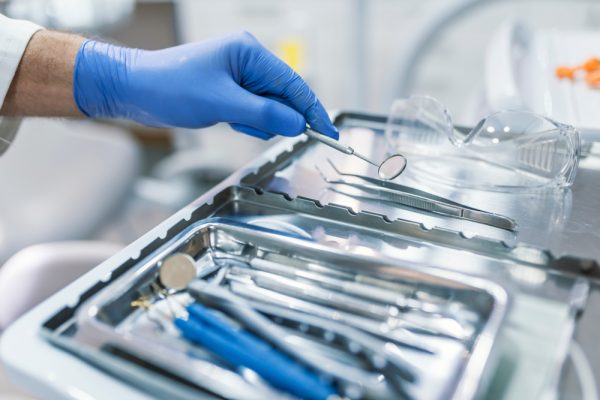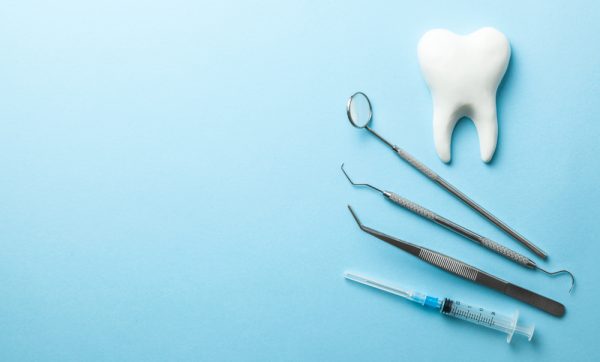How Dentists Clean Your Teeth
Dental cleanings are an essential aspect of maintaining oral health and preventing oral health issues from arising, such as cavities, gum disease, and bad breath. It involves removing plaque, tartar, and other debris from the teeth and gums. To accomplish this, our Wasilla dental professionals use various tools and techniques to ensure a thorough and effective cleaning.

Tools and Techniques Used for Dental Cleanings
Scaling and Root Planing
Scaling and root planing are two common techniques used to remove plaque and tartar from the teeth and gums. Scaling involves removing the buildup of plaque and tartar above the gum line, while root planing smooths out the rough surfaces on the roots of the teeth to prevent further buildup.
It’s often recommended for those suffering from early-stage gum disease. In most cases, the effects of early-stage gum disease are reversed with scaling and root planing.
Polishing Tool
Polishing is the process of smoothing and shining the teeth’s surfaces after scaling and root planing. With a polishing tool, your dentist will polish the teeth after removing plaque and tartar. This process makes it harder for plaque and tartar to accumulate on the teeth, which helps prevent tooth decay and gum disease.
Dental Explorer
A dental explorer is commonly used during exams to detect tooth decay, gum disease, and other oral health problems. It’s a thin, sharp, pointed tool with a flexible, angled tip that allows the dentist or dental hygienist to reach and probe areas that are difficult to see or access.
During an exam, they’ll use the explorer to gently probe the teeth and gums to check for any signs of decay or disease. They may also use it to check the depth of any cavities or pockets in the gums.
Dental Scaler
A dental scaler is a tool used to remove plaque and tartar from the teeth. It has a hooked end that allows it to reach under the gumline to remove debris that brushing and flossing can’t remove.
Dental scalers come in different shapes and sizes to accommodate different areas of the mouth and teeth. They’re usually made of stainless steel and are sterilized before and after each use to prevent the spread of infection.
During a dental cleaning, the dental hygienist will use a scaler to remove any hard deposits of plaque and tartar that have accumulated on the teeth. They’ll use the pointed or curved tip of the scaler to scrape away the buildup from the tooth surface and the gumline.

Ultrasonic Scaler
An ultrasonic scaler is a dental tool that uses high-frequency vibrations to remove plaque and tartar from the teeth. This tool is faster and more efficient than manual scaling and can reduce the time needed for cleaning.
Dental Mirror
A dental mirror is a small mirror used to visualize the teeth’s surfaces and gums during cleaning. It helps your dentist or dental hygienist identify areas of concern, such as cavities, gum disease, or other problems.
During a dental exam, a dental mirror is used to reflect light and view the front and back surfaces of teeth, gums, and other areas inside the mouth. It helps the dental professional get a better view of the teeth and gums, detect any problems or abnormalities, and make an accurate diagnosis.
Curette
A curette is a curved tool used to remove plaque and tartar from below the gum line. It has a sharp, hook-like tip that allows your dentist or dental hygienist to scrape away the buildup from the roots of the teeth. This tool is essential in preventing gum disease and maintaining healthy gums. Using a curette during a dental cleaning can remove any buildup that one can’t reach through regular brushing and flossing.
Dental floss
Dental floss is a thin, waxed string used to remove plaque and food particles from between the teeth. Flossing removes any plaque and food particles that have accumulated between the teeth, preventing tooth decay and gum disease.
Dentists recommend that individuals floss at least once a day to maintain good oral hygiene. During a dental cleaning, your dentist or dental hygienist may demonstrate the proper technique for flossing to ensure the individual is doing it correctly at home.
Suction Device
A suction device, also known as a dental suction or saliva ejector, is a tool used to remove saliva, water, and debris from the mouth during dental procedures. It’s a small, handheld device that consists of a soft, flexible tube with a suction tip at the end.
The suction device goes into the patient’s mouth and the suction tip is placed near the area being worked on. The dental hygienist will use the device to remove saliva and other fluids from the mouth, as well as any debris or particles that may have been generated during the procedure.
Suction devices come in different sizes and shapes to accommodate the areas of the mouth and teeth. They’re usually connected to a vacuum system that generates the suction, which is strong enough to remove fluids and debris but gentle enough to not harm the mouth or teeth.
The use of a suction device is important for maintaining a dry and clean environment during dental procedures, which helps ensure better visibility and accuracy for the dentist or dental hygienist.
Water syringe
A water syringe is used to rinse the mouth during and after the cleaning procedure. This tool can help remove any remaining debris from the mouth and leave the teeth feeling clean and fresh. Water syringes are especially useful for individuals with braces or other dental appliances that can trap food particles and make cleaning more difficult. It’s common to use a water syringe during a dental cleaning to ensure that all areas of the mouth are thoroughly cleaned.
X-Rays
X-rays are an essential tool in the world of dental cleaning. These powerful rays can penetrate through tissues and reveal hidden problems that may not be visible to the naked eye. By using X-rays, dentists can detect cavities, bone loss, and other dental issues early on, allowing them to provide effective treatment before the problem worsens.
X-rays are safe and painless, making them a valuable diagnostic tool for both the dentist and the patient. With the use of dental X-rays, dentists can provide comprehensive care to ensure a healthy and happy smile.
Frequently Asked Questions
Water syringes are generally safe for individuals with sensitive teeth. However, we recommend discussing any concerns or potential issues with your dentist or dental hygienist before using one. They can advise you on the best way to use the syringe and any precautions you may need to take.
The proper technique for using dental floss involves wrapping the floss around your fingers and gently sliding it between each tooth, being careful not to snap it against the gums. Once the floss is between the teeth, curve it around each tooth in a C-shape and move it up and down to remove any plaque or food particles. Repeat this process for each tooth, using a fresh section of floss for each tooth.
Yes, taking a pain reliever before a dental cleaning appointment is a common way to make the experience more comfortable. However, it’s essential to check with your dentist before taking any medication, especially if you have any allergies or medical conditions that may be affected. They may also provide alternative options to make the experience more comfortable, such as numbing gels or sedation.
Check Out Our Easy and Effective Dental Tools and Techniques at Northwind Dental!
With our dental tools and techniques during a dental cleaning, we can ensure a thorough and effective cleaning. If you’re in the Wasilla area and are due for a dental cleaning, contact our dentists to schedule an appointment. We’ll make sure you get the dental care you need.
